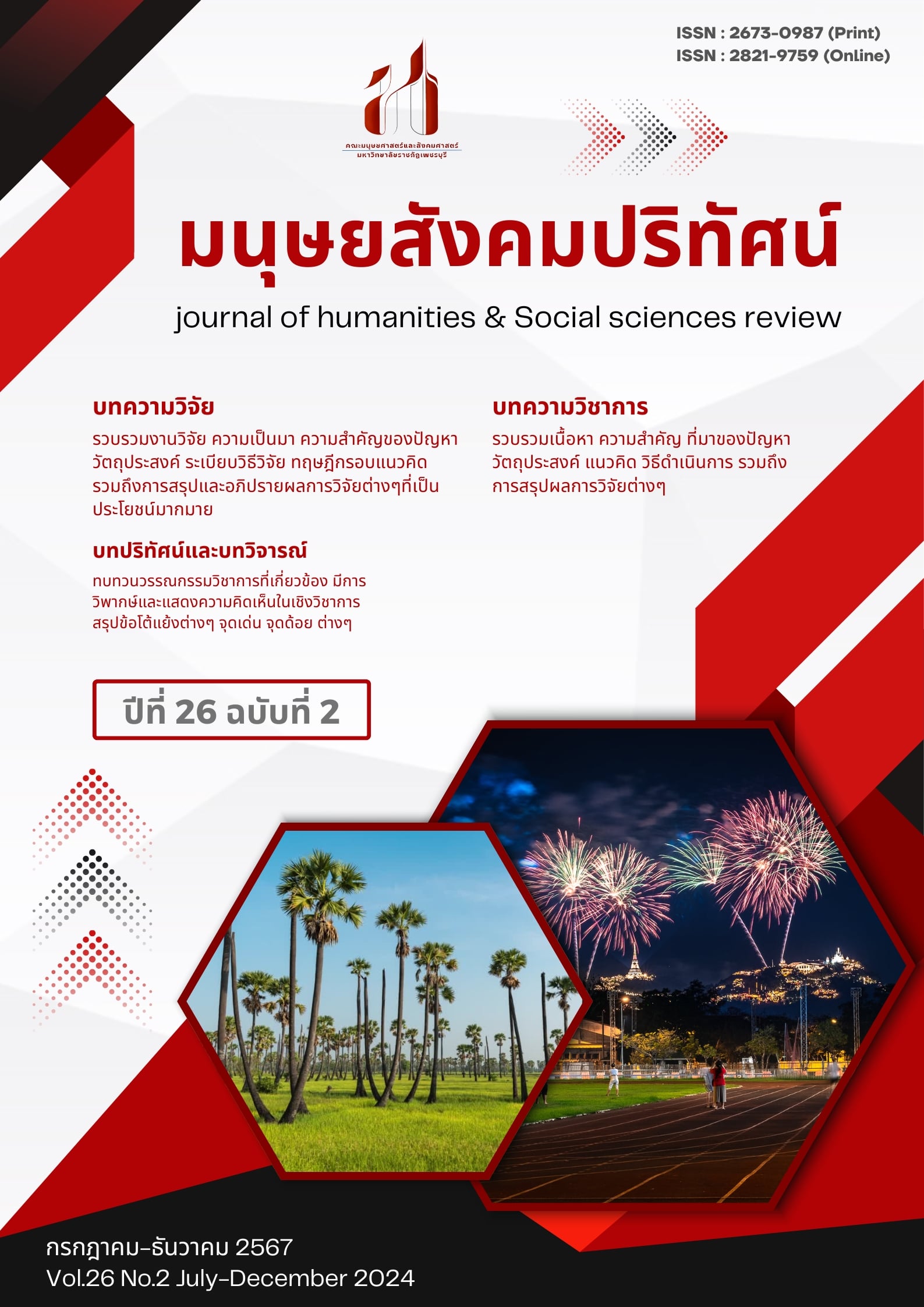การพัฒนาเส้นทางท่องเที่ยวเชิงวัฒนธรรมชุมชนเมืองเก่าเพชรบุรี
Main Article Content
บทคัดย่อ
การวิจัยครั้งนี้มีวัตถุประสงค์เพื่อ 1) ศึกษาบริบทเชิงวัฒนธรรมของชุมชนเมืองเก่าเพชรบุรี ในชุมชนตลาดริมน้ำ ชุมชนคลองกระแชง และชุมชนวัดแก่นเหล็ก 2) พัฒนาเส้นทางท่องเที่ยวเชิงวัฒนธรรมชุมชนเมืองเก่าเพชรบุรี และ 3) ประเมินเส้นทางท่องเที่ยวเชิงวัฒนธรรมชุมชนเมืองเก่าเพชรบุรี มีประชากรและกลุ่มตัวอย่าง ได้แก่ กลุ่มที่ 1 ตัวแทนจากชุมชนตลาดริมน้ำเพชรบุรี ชุมชนคลองกระแชง และชุมชนวัดแก่นเหล็ก ใช้วิธีการสุ่มกลุ่มตัวอย่างแบบเฉพาะเจาะจง กลุ่มที่ 2 คือ กลุ่มนักท่องเที่ยวที่มาท่องเที่ยวในบริเวณชุมชนเมืองเก่าเพชรบุรี จำนวน 104 คน โดยใช้วิธีการสุ่มแบบบังเอิญ เครื่องมือที่ใช้ในการวิจัย ได้แก่ แบบสัมภาษณ์สำหรับตัวแทนชุมชน และแบบสอบถามสำหรับนักท่องเที่ยว สถิติที่ใช้ในการวิเคราะห์ข้อมูลได้แก่ ร้อยละ ค่าเฉลี่ย ส่วนเบี่ยงเบนมาตรฐาน และการวิเคราะห์เนื้อหา ผลการวิจัย พบว่า 1) บริบทเชิงวัฒนธรรมของชุมชนเมืองเก่าเพชรบุรี ในชุมชนตลาดริมน้ำ ชุมชนคลองกระแชง และชุมชนวัดแก่นเหล็ก พบว่า ทั้ง 3 ชุมชน เป็นชุมชนเก่าแก่ที่ยังคงวิถีชีวิต อาหารการกิน อาคารบ้านเรือนศิลปวัฒนธรรม และประเพณีอันทรงคุณค่า มีสถานที่สำคัญในชุมชนที่มีศักยภาพเพียงพอที่จะพัฒนาเป็นแหล่งท่องเที่ยว มีกิจกรรมที่สื่อถึงวิถีชีวิตและภูมิปัญญาของคนในชุมชนที่น่าสนใจ และมีสิ่งอำนวยความสะดวกที่สามารถรองรับนักท่องเที่ยว สามารถพัฒนาเป็นเส้นทางท่องเที่ยวเชิงวัฒนธรรมได้ 2) การพัฒนาเส้นทางท่องเที่ยวเชิงวัฒนธรรมชุมชนเมืองเก่าเพชรบุรี ผู้วิจัยได้พัฒนาเส้นทางท่องเที่ยวเชิงวัฒนธรรมชุมชนเมืองเก่าเพชรบุรี จำนวน 2 เส้นทาง เส้นทางที่ 1 เป็นเส้นทางท่องเที่ยวแบบ 1 วัน ชื่อ “กลิ่นไอถิ่นเมืองเพ็ชร์” ได้แก่ (1) วัดมหาธาตุวรวิหาร (2) ชุมชนวัดแก่นเหล็ก (3) พิพิธภัณฑ์หนังใหญ่วัดพลับพลาชัย (4) รับประทานอาหารพื้นถิ่น (5) ชุมชนคลองกระแชง ศาลาท่าน้ำวัดพลับพลาชัย ลานสุนทรภู่ บ้านมนัส จรรยงค์ ราชาเรื่องสั้นเมืองไทย บ้านเล่าเรื่องมิตร ชัยบัญชา พิพิธภัณฑ์สมบัติแม่น้ำเพชร (6) ศาลาคามวาสี ห้องภาพเพชรบุรี สะพานใหญ่ (7) ชุมชนตลาดริมน้ำ สตรีทอาร์ต บ้านเรียนรู้ตั้งสวัสดิรัตน์ (8) สะพานจอมเกล้า เส้นทางที่ 2 เป็นเส้นทางท่องเที่ยว 2 วัน 1 คืน ชื่อ “เพ็ชร์รีแลนด์แดนวัฒนธรรม” วันที่ 1 ได้แก่ (1) พระรามราชนิเวศ (วังบ้านปืน) (2) วัดมหาธาตุวรวิหาร (3) ลานอุทยานเฉลิมพระเกียรติพระบาทสมเด็จพระจอมเกล้าเจ้าอยู่หัว (4) รับประทานอาหารพื้นถิ่น (5) อุทยานประวัติศาสตร์พระนครคีรี (เขาวัง) (6) วัดพระพุทธไสยาสน์ (7) วัดข่อย (8) เข้าที่พัก วันที่ 2 ได้แก่ (1) ชุมชนวัดแก่นเหล็ก (2) พิพิธภัณฑ์หนังใหญ่วัดพลับพลาชัย (3) ชุมชนคลองกระแชง ศาลาท่าน้ำวัดพลับพลาชัย ลานสุนทรภู่ บ้านมนัส จรรยงค์ ราชาเรื่องสั้นเมืองไทย บ้านเล่าเรื่องมิตร ชัยบัญชา พิพิธภัณฑ์สมบัติแม่น้ำเพชร (4) รับประทานอาหารพื้นถิ่น (5) ศาลาคามวาสี ห้องภาพเพชรบุรี สะพานใหญ่ (6) ชุมชนตลาดริมน้ำ สตรีทอาร์ต บ้านเรียนรู้ตั้งสวัสดิรัตน์ (7) สะพานจอมเกล้า 3) การประเมินเส้นทางท่องเที่ยวเชิงวัฒนธรรมชุมชนเมืองเก่าเพชรบุรี พบว่า นักท่องเที่ยวส่วนใหญ่เป็นเพศหญิง มีช่วงอายุระหว่าง 21 – 30 ปี มีการศึกษาระดับปริญญาตรี เป็นนักเรียน/นักศึกษา อาศัยอยู่ในภาคตะวันตก เคยเดินทางมาท่องเที่ยวชุมชนเมืองเก่าเพชรบุรีแล้ว มาเที่ยวชมชุมชนด้วยสาเหตุความชอบส่วนตัว โดยหาข้อมูลท่องเที่ยวจากอินเทอร์เน็ต ผลการประเมินเส้นทางท่องเที่ยวในชุมชนเมืองเก่าเพชรบุรี พบว่า นักท่องเที่ยวมีความพึงพอใจอยู่ในระดับมากทุกตัวชี้วัด มีค่าเฉลี่ยรวม เท่ากับ 4.12 โดยสิ่งที่นักท่องเที่ยวมีความพึงพอใจ 3 ลำดับแรก ได้แก่ กิจกรรมท่องเที่ยวมีความปลอดภัยต่อนักท่องเที่ยว มีบริการร้านอาหารและเครื่องดื่มเพียงพอต่อความต้องการของนักท่องเที่ยว และการคมนาคมขนส่งมีความสะดวกในการเข้าถึง
Article Details
1. มุมมองและความคิดเห็นใด ๆ ในบทความเป็นมุมมองของผู้เขียน คณะบรรณาธิการไม่จำเป็นต้องเห็นด้วยกับมุมมองเหล่านั้นและไม่ถือเป็นความรับผิดชอบของคณะบรรณาธิการ ในกรณีที่มีการฟ้องร้องเกี่ยวกับการละเมิดลิขสิทธิ์ ให้ถือเป็นความรับผิดชอบของผู้เขียน แต่เพียงผู้เดียว
2. ลิขสิทธิ์บทความที่เป็นของคณะมนุษยศาสตร์และสังคมศาสตร์ มหาวิทยาลัยราชภัฏเพชรบุรีมีลิขสิทธิ์ถูกต้องตามกฎหมาย การเผยแพร่จะต้องได้รับอนุญาตโดยตรงจากผู้เขียนและมหาวิทยาลัยราชภัฏเพชรบุรีเป็นลายลักษณ์อักษร
เอกสารอ้างอิง
ชายชาญ ปฐมกาญจนา และนรินทร์ สังข์รักษา. (2556). แนวทางการส่งเสริมการท่องเที่ยวเชิงวัฒนธรรมแบบมีส่วนร่วมของชุมชนตลาดบางหลวง อำเภอบางเลน จังหวัดนครปฐม. วิทยานิพนธ์มหาบัณฑิต สาขาวิชาพัฒนศึกษา มหาวิทยาลัยศิลปากร.
ณัฐวุฒิ สุวรรณช่าง. (2558). วิถีชีวิตของชาวไทยเชื้อสายจีนในชุมชนวัดเกาะ อำเภอเมืองจังหวัดเพชรบุรี. เพชรบุรี: คณะมนุษยศาสตร์และสังคมศาสตร์ มหาวิทยาลัยราชภัฏเพชรบุรี.
เบญจา จันทร. (2545). แนวทางการพัฒนาตลาดดอนหวาย อำเภอสามพราน จังหวัดนครปฐมให้เป็นแหล่งท่องเที่ยวทางวัฒนธรรมโดยการมีส่วนร่วมของชุมชน. เชียงใหม่: มหาวิทยาลัยเชียงใหม่.
ปรัชญาพร พัฒนผล. (2554). การพัฒนาเส้นทางท่องเที่ยววัฒนธรรมแม่น้ำเพชรบุรี. กรุงเทพฯ: มหาวิทยาลัยธรรมศาสตร์.
ลัคนา ชูใจ และคณะ. (2550). การศึกษาบริบทแหล่งท่องเที่ยวเชิงวัฒนธรรมของชุมชนวัดเกาะ. เพชรบุรี: คณะมนุษยศาสตร์และสังคมศาสตร์ มหาวิทยาลัยราชภัฏเพชรบุรี.
วีรพร รอดทัศนา. (2556). การจัดการท่องเที่ยวเชิงวัฒนธรรมของกลุ่มไทยพวน: กรณีศึกษาชุมชนเก้าห้อง อำเภอบางปลาม้า จังหวัดสุพรรณบุรี. กรุงเทพฯ: มหาวิทยาลัยธุรกิจบัณฑิตย์.
WP. (2562). ล้วง Insight การใช้งาน “ดิจิทัล” ทั่วโลก 2019 “คนไทย” ใช้เน็ต 9 ชั่วโมงต่อวัน-มือถือมี 99 แอป. สืบค้นเมื่อ มีนาคม 1, 2566, จาก https://www.marketingoops.com/reports/global-and-thailand-digital-trend-2019/.


